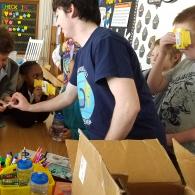Davenport West InvenTeam April Update
On April 12th, members of the Davenport West High School InvenTeam visited Jefferson Elementary, a local school that does not have access to consistent extracurricular STEM experiences such as FIRST robotics. Fifth-grade students were guided through instructional activities encompassing the importance of safe access to clean water. The students were separated into 3 groups and cycled through each InvenTeam student-led activity. This event acts as the first student-testing of the educational materials the Davenport West Lemelson-MIT InvenTeam is developing.
The exercises included fun-fact coloring, hands-on water flocculation experiment, and interactive microscope challenge. Within each activity, students were led by their own questions with answers that related to water quality and contaminants, accessibility privileges, and international water crisis awareness.
Within the first activity, students colored upon sheets of paper with images of water-borne bacteria under the microscope. Student questions ranged from "Why does bacteria in water make us sick?", to "How do we get our water in America?". While coloring, students were taught about the differences in water filtration systems in the United States versus communities with blighted access to water, such as Muamba, Kenya. In all, the students were much more informed upon where their water is coming from and the process by which it is filtered.
The second activity involved visually representing the concept of flocculation. Students were able to deposit mud and other sediments into two gallons of tap water. They stirred the sediments and discussed the change in turbidity. Once the water was at its maximum opacity, the InvenTeam members added a P&G water-cleaning packet and stirred. This packet was explained to students as particles that “grab onto” the dirt and cause them to sink to the bottom. While the water cleared, students were asked questions by the InvenTeam members. Questions were directed to increase the students water-consumption consciousness, to emphasize the importance of clean water, and to relate community issues with those abroad.
The third activity involved the use of Foldascopes, which are affordable, paper microscopes that are assembled with simple materials and instructions. Students utilized the pre-assembled microscopes to examine and distinguish slides of bacteria. This activity was designed to test the success of the InvenTeam’s pre-written instruction on how to use the equipment. InvenTeam students also were able to examine the challenge of a language barrier by communicating with a non-English speaking student.
Upon interacting with a large group of children, the team collected student responses in order to gage which activities provided the most educational retainment. Students were also given the opportunity to discuss which activities they enjoyed the most. The team hopes to use similar, engaging activities with children in Muamba, Kenya to develop a central water-education practice further.
In regards to EurekaFest preparation, the market research team was converted into a model building team for the final stages of the grant term. This change of focus more properly aligns with the remaining time allotted for project completion. Coupled with all previous CAD files and new building material, the team is working towards creating two separate models. One model will be a working 1/5 scale of the current working prototype, while the other will be a display model around 1/10 of the size of the working prototype. Developing two scale models will allow for a more through an explanation in regards to the technical presentation.


